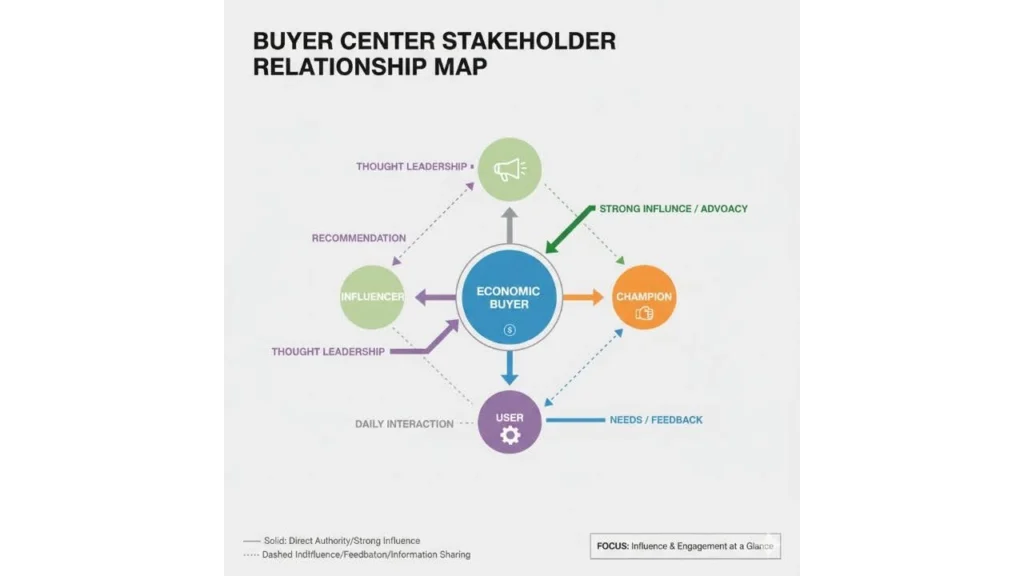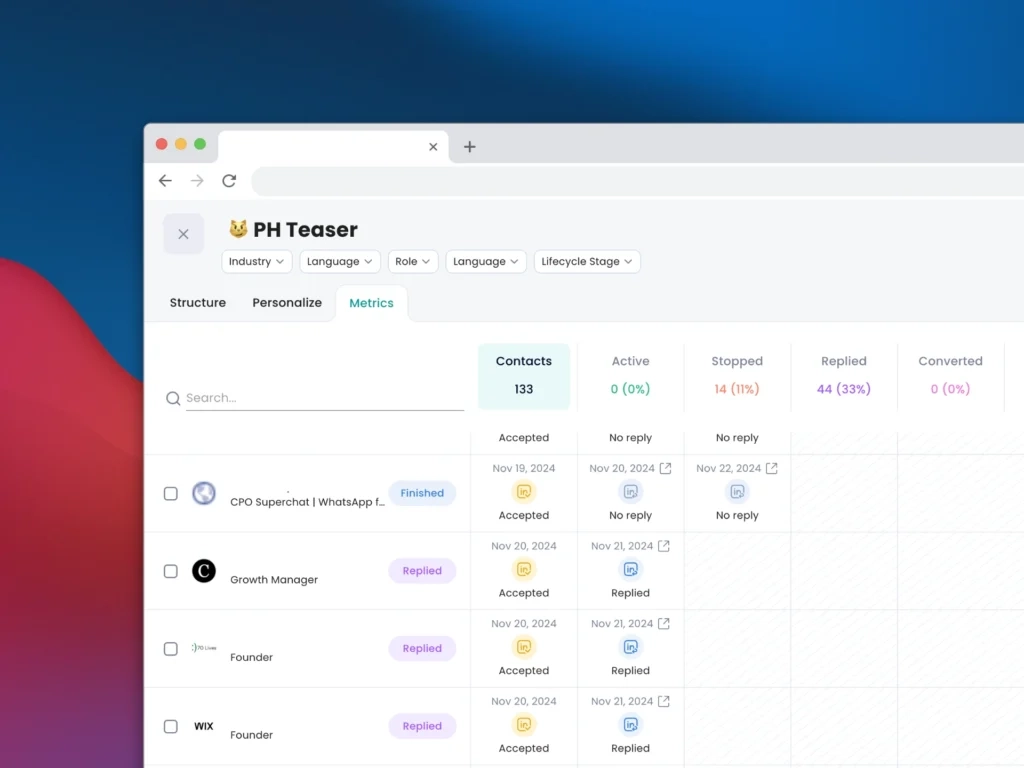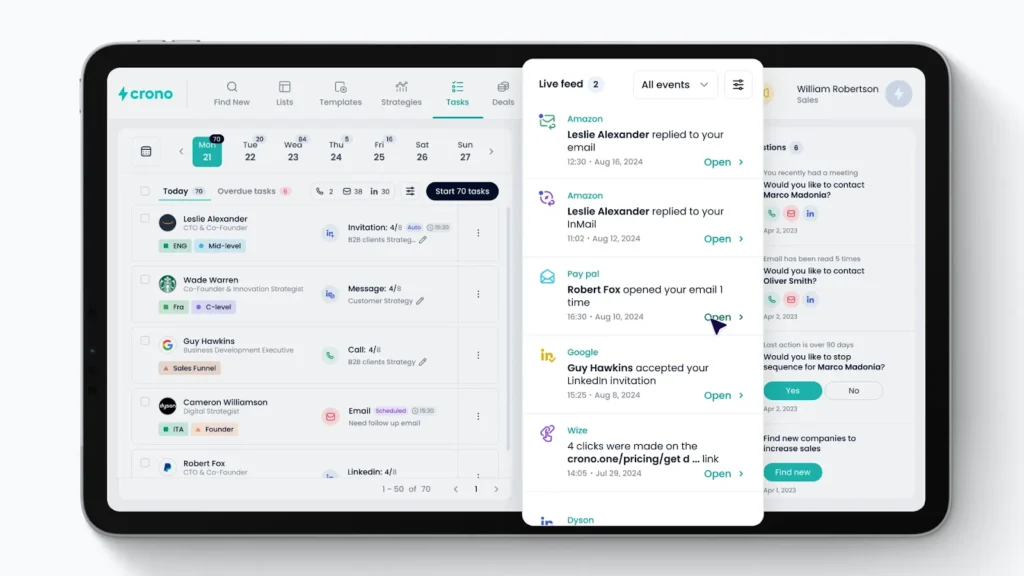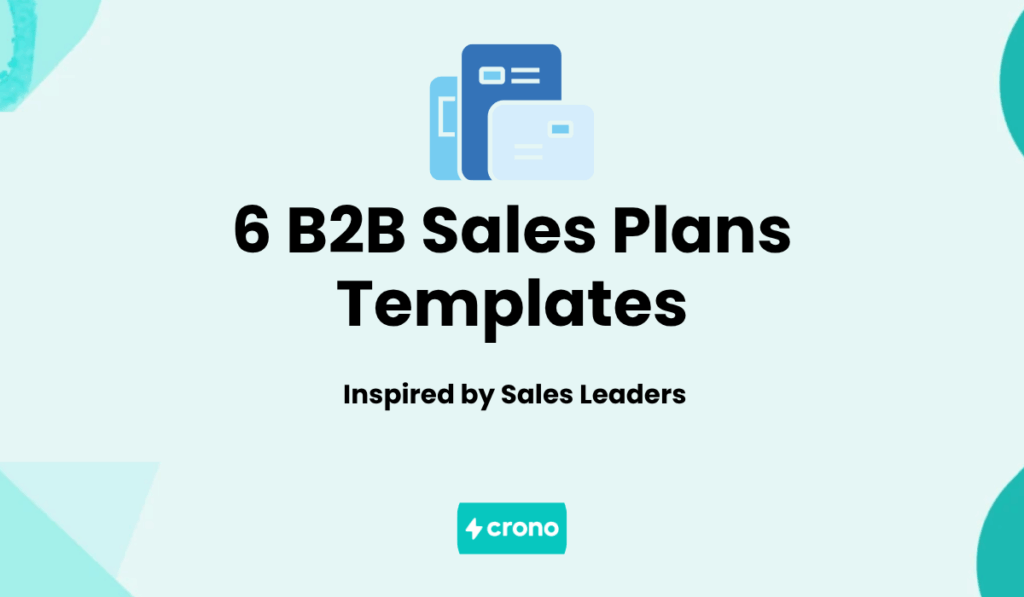Below, you’ll find battle-tested templates inspired by strategies from top sales leaders like Nate Hiser, Noam Hisand, and Sarah van Sickle. Each one is designed to help you hit targets and close deals:
- General B2B sales plan template
- Cold calling strategy template
- Social selling template
- Product launch template
- Partnership selling template
- 30/60/90 B2B sales plan template
Already have your sales plan mapped out? Great! Jump to the template that fits your needs and start customizing.
If you’re still shaping your strategy, keep reading. We’ll walk through the key elements of a B2B sales plan first. Because even the best template can’t rescue a weak strategy.
1. General B2B sales plan template
This template covers all the key sections a B2B sales plan should have—executive summary, OKRs, target personas, sales process, performance metrics, and sales targets. That way, you can map out a clear, actionable plan without having to start from scratch.
Adapt it to any industry or team size and get straight to planning.
[Copy the general sales plan template here]
Best for: Sales managers building territory plans, AEs entering new markets, or leaders establishing standardized processes across teams.
2. B2B sales plan template for cold calling strategy
Cold calling is often dismissed as outdated, yet top performers still use it to win new business. What sets their approach apart?
Jack Frimston, celebrated for his high-conversion campaigns, told us in a recent conversation that his results come down to two habits:
- Internal motivation: Focus on the upside of every call—new opportunities, stronger networks, potential deals—so the reward outweighs the fear of rejection.
- People over pipeline: Treat each prospect as a person with a problem you can solve. Build rapport first, then present your solution.
So, we decided to create a template inspired by these insights to help you create a cold-calling plan.
[Copy the template for the cold calling strategy]
Best for: Breaking into new accounts, launching outbound campaigns, or industries where warm introductions are difficult to secure.
Want to cold-call without breaking your workflow?
Crono integrates with Aircall so you can find verified phone numbers and call prospects directly from the same platform you use for email and LinkedIn outreach. This centralizes your call activity, email responses, and LinkedIn engagement in one place, so your team can generate buyer intelligence faster and prospect better.
3. B2B sales plan template for social selling
If cold outbound is underperforming—or if you work in a trust-sensitive industry such as finance, healthcare, or professional services—social selling is a better way to generate warm leads.
Today’s buyers make that shift necessary. They:
- Distrust messages delivered using traditional sales tactics.
- Prefer to self-educate for up to 75% of the buying journey before speaking with a rep.
- Set a high trust barrier that every salesperson must overcome before they consider buying.
When we spoke to Nate Hiser (SMB Account Executive at Seven Figure Creators) and Noam Hisand (Founder, Leed Services), they distilled the entire social selling process into four practical steps:
- Daily public engagement – Comment thoughtfully on posts from industry thought leaders and your ideal customer profile (ICP) to build visibility and credibility.
- 1:1 conversations – Move high-engagement prospects into direct messages, asking questions and offering insights—never a hard pitch.
- Value-first outreach – Share free resources and tailored advice that prove your expertise before requesting a meeting.
- Personalization — Send connection requests and messages personalized to the prospect.
We decided to create a fillable template based on these principles to help you put these insights into action.
[Copy the social selling sales template]
Best for: Complex, high-touch sales cycles where credibility and relationship-building drive success.
4. B2B sales plan template for product launch
Launching something new and eager to build momentum fast? Simon Stanisz, founder of NorthStar Consulting, has helped dozens of companies do just that—and he shared with us the three-step approach he relies on to spark early traction:
- First, zero in on early adopters—the people most likely to recognize immediate value and spread the word.
- Second, lead with emotion and back it with logic. Excite prospects first, then give them the proof they need to believe.
- Finally, treat every interaction as a stepping stone. Instead of pushing for an instant close, aim for a clear next step—like a scheduled follow-up—so the conversation keeps moving forward.
We’ve turned Simon’s insights into a ready-to-use product launch template you can download and apply right away.
[Copy the sales plan template for product launch]
Best for: Product marketing managers, sales teams launching new offerings, or expansion into adjacent markets.
5. B2B sales plan template for partnership selling
In B2B sales, partnerships can open doors to new markets, shared audiences, and co-created opportunities. But they can also fall apart if expectations aren’t aligned or communication breaks down.
Recently, we asked Sarah van Sickle, Head of Partnerships at Topo.io, about building healthy partnerships that deliver sales revenue. Here are three key elements she pointed out:
- Trust: Both parties keep commitments and share information transparently
- Clear goals: Measurable outcomes that all stakeholders agree on from the start
- Open communication: Regular updates and established channels for quick issue resolution
We packaged these three pillars into a single, downloadable plan to help you launch and scale partnership deals faster.
[Copy the sales plan template for partnership selling]
Best for: Channel sales roles, strategic partnerships, or market expansion through existing relationships.
6. Template for 30/60/90 B2B sales plan
Need to create a 30-60-90 day plan for a senior sales role, but staring at a blank page with no idea where to start?
Here’s a template that provides a ready-made 30/60/90-day structure that hiring managers love and new reps can execute immediately.
[Copy the template for 30/60/90 sales plan]
Best for: Sales professionals interviewing for new roles or creating a short-term action plan to share with leadership.
Presenting a sales plan internally? Here are 8 must-have sections
Your sales plan needs to connect strategy (the why) with execution (the how)—giving leadership a clear understanding of your plans and your team a precise roadmap for next steps. Make it detailed enough to guide daily work but concise enough that busy executives will actually read it.
Here’s a simple structure to make that happen:
1. Kick off with a concise executive summary
Start by adding an executive summary. This should provide everyone on your team with a clear and concise overview of your sales strategy and the expected outcomes, even without reading the rest of the document.
Ensure to tailor this section to contain key points that matter most to the people who will read it:
- For sales teams: Focus on revenue targets, territory assignments, activity goals, and timeline milestones.
- For executives: Highlight how the strategy aligns with broader company objectives. Capture the expected results in terms of financial impact.
2. Set bold, measurable objectives (OKRs)
Right after the executive summary, lay out 1–3 bold yet realistic sales objectives, each backed by 2–4 measurable key results. Every objective must directly support the company strategy, or you risk hitting your numbers while missing broader business goals.
For example, if your organization plans to enter a new region by year-end, your OKR could look like this:
| Objective | Key Result 1 | Key Result 2 | Key Result 3 |
|---|---|---|---|
| Increase annual recurring revenue (ARR) by 25% in FY25, driven by growth in DACH and APAC. | Close 40 enterprise deals in DACH & APAC, averaging $60K ARR each. | Maintain an average sales cycle ≤ 60 days to speed market entry. | Lift average deal size by 15% through region-specific upsell and cross-sell programs. |
| Secure a sustainable presence in DACH and APAC to support long-term global growth. | Add 150 qualified target accounts in each region by Q3. | Sign two local channel partners per region to provide on-the-ground support. | Build a combined $1 million qualified pipeline from these regions by year-end. |
| Increase team productivity and readiness to sell across multiple geographies. | Achieve 95% CRM adoption with <10% manual data entry for clean global data. | Provide regional market training to 100% of sales reps within 60 days of launch. | Reduce onboarding time for new international hires from 90 to 60 days. |
Want to set OKRs that are ambitious, yet achievable?
Crono helps you analyze sales data like deals closed, lead conversion rates, and activity rates. With these metrics, you can set OKRs, revenue targets, and sales quotas that are based on proven output, rather than guesswork.
- Objective: Increase ARR by 25% in FY25, driven by growth in DACH and APAC
- Key Result 1: Close 40 enterprise deals averaging $60K ARR each
- Key Result 2: Maintain average sales cycle ≤ 60 days
- Key Result 3: Lift average deal size by 15% through upsell programs
3. Pinpoint your ideal customers and buyer personas
In the third section, map who you want to sell to at two levels:
- Company-level ICP – the type of business that’s a perfect fit.
- Buyer-level personas – the people inside those companies who influence the deal.
Say you’re a SaaS startup selling compliance software. You’ll need to define your company-level ICP using their industry, size, revenue, location, budget readiness, tech stack, and primary pain points.
Here’s what that looks like:
| Category | Details |
|---|---|
| Company Profile (ICP) | |
| Industry | Digital-first retailers, subscription-based e-commerce brands, and mid-market B2B SaaS vendors. |
| Size & revenue | 100–500 employees; annual revenue of $20M–$150M. |
| Location | North America and Western Europe have established digital marketing operations. |
| Budget readiness | Marketing technology budgets of at least $250K annually, with a track record of investing in analytics and AI. |
| Technographics | Uses Salesforce or HubSpot CRM, Google Analytics, and a major marketing automation suite (Marketo, HubSpot). |
| Primary Pain Points | Inability to attribute ROI to campaigns, fragmented customer data, slow manual reporting, and wasted ad spend. |
Within those ICPs, identify people who serve as the economic buyer, champion, user, and potential blocker. For each persona, capture their goals, pain points, success metrics, and specific reasons why your solution fits their needs right now.
Here’s a perfect example:
| Buying Center Personas | ||
|---|---|---|
| Economic buyer | CMO or VP Marketing – Owns the budget, sets strategic marketing goals, and demands clear ROI. | Key Needs: Reduce CAC, prove campaign ROI, and optimize marketing spend. |
| Champion | Marketing Director or Digital Marketing Lead – Day-to-day owner of marketing operations who drives internal adoption. | Key Needs: Streamlined analytics, faster reporting, actionable insights for campaigns. |
| User | Marketing Manager, Content Strategist, or Data Analyst – Directly uses the platform for reporting and optimization. | Key Needs: Intuitive dashboards, easy integrations with existing tools, and accurate data. |
| Influencer/blocker | Head of IT or Data Security – Reviews security, compliance, and integration requirements. | Key Needs: Reliable API integrations, strong data security, and low implementation risk. |
After defining the buyer-center personas, add a stakeholder relationship map to show all key players in one view. This makes each person’s influence and engagement level instantly clear, so your team knows where to focus next.
To see what this looks like in practice, check out the example stakeholder relationship map below:

4. Map a sales process reps will follow
Outline the repeatable steps for moving prospects from initial contact to signed contracts, based on your sales methodology. Include:
- Deal stages (qualification, discovery, proposal, negotiation, close)
- Key activities and sales tactics at each stage, aligned to your chosen methodology
- Exit criteria that signal readiness to advance (budget confirmed, decision-maker engaged, etc.)
When mapping your sales process, aim for 5 to 7 steps. To achieve this, work with your reps to determine the steps that drive a deal forward and cut the rest. That way, the document is seen as a helpful tool, rather than a chore.
Let’s say you’re using the solution-selling methodology to close deals. Your sales process section in your sales plan will look like this:
| Stage | Specific Key Activities | Exit Criteria (Advance When...) |
|---|---|---|
| Lead qualification |
Run outbound sequence: 3 calls + 2 emails + LinkedIn connect. Ask BANT questions on the first live call to confirm budget range, decision authority, key pain, and timeline. |
Prospect meets BANT minimums: verified budget range, decision-maker identified, clear business need, and purchase window within 6 months. |
| Discovery |
Schedule a 45-minute discovery call with the decision-maker and influencer. Map current marketing workflow and analytics gaps. |
A signed-off discovery summary in CRM, including quantified pain, success metrics, and stakeholder alignment. |
| Solution mapping |
Create a custom solution brief that includes product modules, an integration plan, and a 12-month ROI projection. Email a brief to the buying team and schedule follow-up Q&A. |
The buying team confirms the proposed solution addresses all documented needs and agrees on success metrics. |
| Proposal |
Draft and deliver formal proposals with itemized pricing, timeline, and ROI justification. Log any requested changes in CRM. |
The economic buyer acknowledges receipt of the proposal and provides initial feedback or requests revisions. |
| Negotiation |
Hold a dedicated negotiation call with legal/procurement and the economic buyer. Finalize pricing tiers, payment terms, and service-level agreements. Secure verbal “go” from decision-maker. |
All commercial and legal terms agreed; verbal commitment documented. |
| Close & handoff |
Send the DocuSign contract and follow up until signature. Introduce the customer success manager in a joint kickoff email. Schedule onboarding call within 7 days of signature. |
Signed contract received and onboarding date confirmed with the customer success team. |
5. Prioritize accounts for maximum impact
Create a framework for prioritizing your book of business. That way, you focus energy on accounts that deliver the biggest return, instead of spreading effort thin.
Most successful reps use A/B/C tiering:
- A accounts: Highest revenue potential, requires significant time investment
- B accounts: Moderate potential, efficient resource allocation
- C accounts: Lower priority, minimal touch or automated outreach
For instance, if you’re targeting the U.S. mid-market, an A account might be a healthcare provider with nationwide clinics, B a regional chain, and C a small local practice.
6. Craft value propositions to guide prospect interactions
Spell out how your solution tackles the key challenges in your market. This will become the core message behind every email, call, and demo.
Start with one overarching value proposition that captures your product’s unique business impact. Then create persona-specific versions for each buyer you’ve identified, showing how their current pain points are solved in ways competitors can’t match.
This ensures every prospect interaction speaks directly to the right problems with a clear, differentiated solution.
For example, imagine you’re selling a workflow automation platform to mid-sized healthcare providers. Your overarching value proposition could be:
- Accelerate patient intake and eliminate manual errors by unifying scheduling, electronic forms, and EHR data in a single automated workflow—reducing wait times and data-entry mistakes by up to 40% compared with standard EHR modules.
From there, the value propositions for each key buyer persona will be like this:
| Buyer Persona | Pain Point | Persona-Specific Value Proposition |
|---|---|---|
| CFO (Economic Buyer) | Rising administrative costs | Cut manual paperwork costs by up to 30% in the first year. |
| Operations director (Champion) | Slow patient intake and bottlenecks | Reduce check-in time from 15 minutes to 5, improving patient flow and staff efficiency. |
| IT manager (Influencer) | Security and compliance concerns | Meet HIPAA standards with built-in data encryption and automated audit trails. |
| Frontline staff (User) | Repetitive, error-prone data entry | Eliminate double entry with a single interface for all patient records. |
7. Break execution into clear 30/60/90 phases
Missed quotas usually start as unseen bottlenecks—too few demos booked, proposals delayed, or missing buy-in. To catch these risks early, break your strategy into 30/60/90-day phases, each with clear milestones and measurable outputs.
This lets you spot warning signs before they derail the quarter.
For example, if your goal is to close 40 enterprise deals in one quarter:
- First 30 days – Learn and connect: Finalize target account list, onboard the team, and book initial discovery calls.
- Days 31-60 – Execute and build pipeline: Run outreach campaigns, deliver demos, and move qualified opportunities into proposal stage.
- Days 61-90 – Optimize and scale: Negotiate contracts, close deals, and identify upsell opportunities.
8. Define review cadence and metrics to track progress
Keep your plan on course with a regular review schedule and clear metrics. Set weekly pipeline reviews, monthly performance checks, and quarterly business reviews to stay on top of progress.
A common mistake is focusing only on lagging metrics like monthly recurring revenue (MRR), average deal size, win rate, or customer retention. These metrics measure final outcomes. By the time they signal trouble, it’s often too late to react.
To create a stronger plan, track the lagging metrics alongside qualified meetings booked, opportunities created, and proposals sent. That way, you can adjust activity levels or messaging when leading indicators dip, before revenue suffers.
Suppose your goal is to close $1 million in new ARR this quarter. The leading and lagging metrics, and review cadence will be:
| Type | Metrics to track | Review cadence |
|---|---|---|
| Leading | Weekly qualified meetings proposals sent | Weekly pipeline review |
| Opportunities moving to proposal stage | ||
| Outbound email response rate | ||
| Lagging | Closed-won revenue | Monthly and quarterly reviews |
| Average deal size | ||
| Churn or retention rate |
This makes it easier to identify issues early. For example, if weekly meetings drop below target by week three, you can immediately increase prospecting or refine outreach instead of discovering the shortfall at the end of the quarter.
How Crono Helps B2B Teams Execute Sales Strategies
Want to turn your sales plan into revenue without draining budget on multiple sales tools? Crono helps your team execute faster by uniting lead generation, prospecting, outreach, and performance tracking in one platform. You can:
- Identify key decision-makers and see how they connect inside each account using LinkedIn integration and advanced filters.
- Enrich contacts automatically with verified emails and phone numbers, so every campaign starts with clean, accurate data.
- Run personalized multichannel sequences across email, LinkedIn, and calls—stopping the moment a prospect responds.
- Automatically log all notes in Salesforce, Pipedrive, or Hubspot—no manual data input required.

- Track pipeline and rep performance in real-time with live analytics dashboards without micromanaging your reps.

Ready to execute your entire sales strategy from a single interface? Book a personalized demo today
Frequently Asked Questions About Creating Sales Plans
A framework for setting specific goals and performance milestones during your first 30 days, next 30 days (60 total), and final 30 days (90 total) in a new role. It's commonly requested in sales interviews and essential for a successful ramp-up.
A sales plan covers your overall go-to-market strategy, including territory management, process, and resource allocation. An account plan focuses specifically on one strategic account—stakeholder mapping, competitive landscape, and deal strategy for that specific opportunity.
A sales plan is your forward-looking strategy for achieving specific objectives. A QBR (Quarterly Business Review) is a retrospective analysis of results against your plan, used to identify lessons learned and adjust future strategy.
Every effective B2B sales strategy must include: clear OKRs aligned with company objectives, a detailed ideal customer profile and buyer personas, a documented sales process with exit criteria, and established metrics for tracking both leading and lagging indicators of success.
It should be directly tied to your company’s goals, reflect current market data, and set targets that your team can realistically achieve. To make it concise and easy to read, include only the essentials, such as objectives and key results, target accounts, key activities, and forecasted outcomes.
